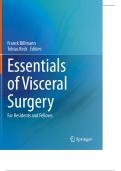Summary
Summary Essentials of Visceral Surgery For Residents and Fellows Springer Verlag
- Institution
- Agrosy University
urgery. Medical expertise in visceral surgery and bystanding subjects has seen a continuous and rapid increase in knowledge in recent years. The increasing specialization in surgery has led the editors to the present concept of a short compendium, which allows the reader to access the current ...
[Show more]












